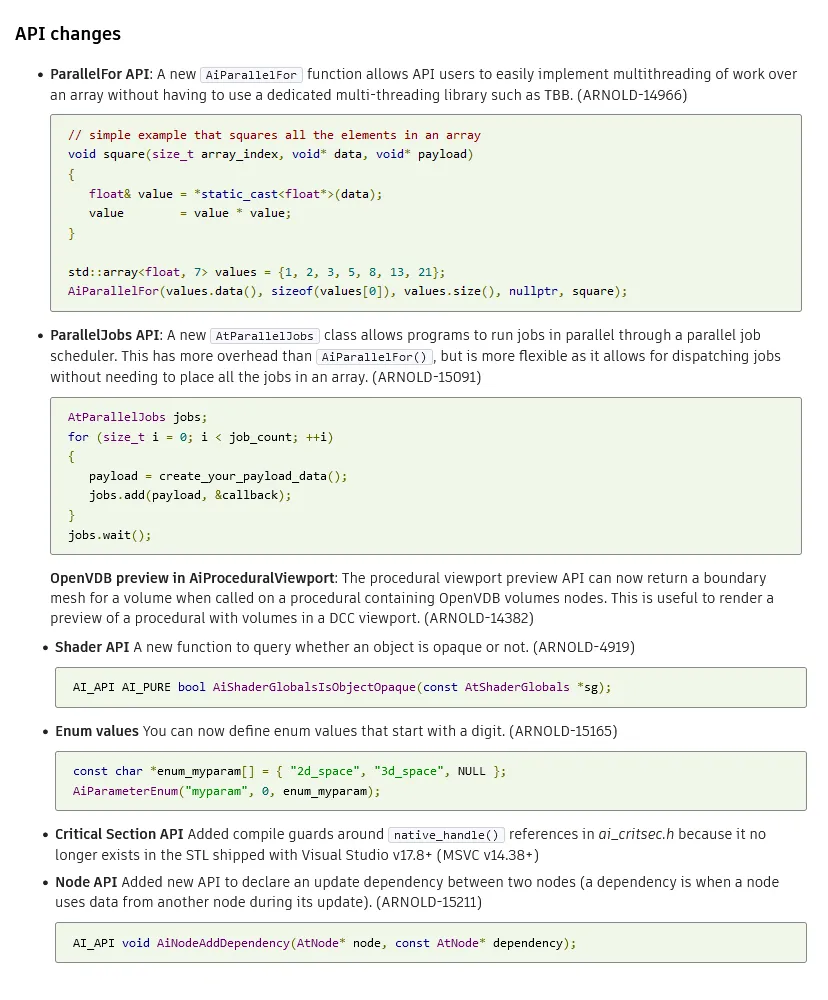Solid Angle Cinema 4D to Arnold 4.7.5 (x64)

Free Download Solid Angle Cinema 4D to Arnold 4.7.5 | 5.6 Gb
Solid Angle, a bussines Autodesk, is pleased to announce the availability ofArnold 4.7.5 for Cinema 4D. This release uses Arnold 7.3.3.0 and is a minor feature release bringing a new OpenPBR surface shader, improvements to volume rendering, OIDN support for Apple Metal and AMD GPUs, and many other improvements as well as multiple bug fixes
Owner:Solid Angle
Product Name:Arnold for Cinema 4D
Version:4.7.5
Supported Architectures:x64
Website Home Page :www.arnoldrenderer.com
Languages Supported:english
System Requirements:Windows, macOs & Linux *
Size:5.6 Gb
.
Enhancements
-OpenPBR Surface:A new openpbr_surface shader implements the OpenPBR specification. OpenPBR Surface is an evolution of Standard Surface, developed in collaboration with Adobe and the Academy Software Foundation. It introduces many improvements, in particular a better sheen/fuzz model and improved metal reflectivity parameterization. (ARNOLD-13385)

Close
-Convert standard surface to OpenPBR surface shader:You can convert standard surface shaders to OpenPBR shaders from the Arnold > Utilites > Material menu or directly from the standard surface shader UI. (C4DTOA-3216)
-Scattering diffusion in volumes:Two new parameters in standard_volume improve how light is scattered in volumes. Using those parameters can help achieve high-scattering looks with fewer volume bounces and without adding energy. (ARNOLD-14482)
. scatter_diffusion accelerates scattering in volumes.
. scatter_diffusion_roughness accelerates scattering further on anisotropic volumes and can help achieve realistic looking clouds with fewer bounces.
. gain and bias curves can further tweak the effect of both parameters

Close
-Stochastic volume interpolation:The tricubic interpolation mode of AiVolumeSampleXXX() calls, such as those used by the standard_volume shader, now uses a stochastic method of interpolation that greatly reduces the amount of voxel data read in each sample call. In testing, we've seen speed ups of as much as 1.7x in certain scenes. Note that this technique does not always produce a perfectly matching image as a result, and can be toggled via the stochastic_volume_interpolation render option (default is on). (ARNOLD-3856)
-Improved quality with Intel Open Image Denoise 2.3.0:The updated Intel Denoiser improves denoising quality and can produce sharper results with less artifacts on scenes with specular reflections and transmission. For more information about changes in this version, see the OIDN release notes (ARNOLD-15059).


Close
-OIDN support for Apple Metal and AMD GPU:The Intel OIDN denoiser now supports on macOS all Apple Metal GPUs (M1 and newer) and on Windows AMD GPUs using RDNA2 (Navi 21 only) and RDNA3 (Navi 3x) architectures. This allows for significantly faster denoising: on an M1 Max laptop we see 5-8x faster denoising. (ARNOLD-14855, ARNOLD-14856)
-GPU Many-lights support for light linking:Arnold GPU now uses Global Light Sampling for group of lights linked to a shape. This can improve rendering performance for scenes with light linking. For example, the ALab scene now renders twice as fast when you use Global Light Sampling. (ARNOLD-15050)
-GPU improved time to first pixel in scenes with many nodes:Reduced time to first pixel with Arnold GPU and scenes with many nodes. For example, we have seen a 18% improvement in time to first pixel on a simple scene with 1,000,000 instances. (ARNOLD-13652)
-Motion vector AOV on GPU:The motionvector AOV is now supported when rendering on GPU. (ARNOLD-11046)
-3D ramp modes:Ramp shaders have three new modes: 3d_linear, 3d_spherical, and 3d_cylindrical. These modes calculate the ramp input from the distance between the shading point and a user-defined reference point or line. (ARNOLD-15051, ARNOLD-15196)
3d_linear 3d_spherical 3d_cylindrical
-Ramp offset:Ramp shaders can now offset the input value, which allows you to add noise to the ramp. (ARNOLD-15052, ARNOLD-15197)
worley noise (3d_spherical) cell_noise (u) alligator noise (v)
-Heatmap Imager Mode:The tonemap imager now has a heatmap mode that creates a spectrum based on a looked-up AOV quantity. The color ranges from blue (at minimum) to red (at maximum) (ARNOLD-15123).
-Improved AOV memory usage in non-progressive renders:Non-progressive, adaptive renders with the box filter now use less memory. Memory usage is also reduced in non-adaptive renders when using the following filters gaussian_filter, triangle_filter, sinc_filter, catrom_filter, mitnet_filter, blackman_harris_filter. For example, in a 1080p render using adaptive with AA_samples_max 50 and 6 AOVs, the memory used by AOVs was reduced from 14GB to 730MB (-96%). Note also that AOV memory usage now remains constant as AA_samples_max increases, unlike previous releases where the memory would increase quadratically. (ARNOLD-10160)
-Improved efficiency of the Alembic procedural:The Alembic procedural now reads data in parallel, which optimizes initialization times of heavy Alembic files with many objects. We observed startup times going from 15 minutes to 4 seconds on a large production scene. (ARNOLD-14796)
-Indirect diffuse and indirect specular parameters are now linkable in the standard_surface and openpbr_surface shaders:The indirect_diffuse and indirect_specular of standard_surface and openpbr_surface shaders now support linking of shaders. This should allow better optimization in scenarios where no indirect lighting is needed. (ARNOLD-14204)
-Triplanar Nref user param:Triplanar shader now accepts an Nref user parameter, to allow specifying reference normals when in Pref mode. (ARNOLD-15063)
-AOV names used for OpenImageIO subimages:Multi-part files previously used default subimage naming for layers/subimages. Arnold now uses the names of AOV outputs for the corresponding subimage. (ARNOLD-15053)
-Triangle tessellation memory usage statistics grouped under polymesh memory usage:Arnold logs now list triangle tessellation and polymesh memory usage together in the peak CPU memory used and peak GPU memory consumed. (ARNOLD-15194)
USD Enhancements
-Skinning on USD curves and points- Binding skeleton on BasisCurves and points will now work with the procedural. usd#1814
-User data on lights- Primvars on lights are now imported as user data on Arnold light nodes. usd#1939
-Improved quad and mesh light exports- Mesh lights are now exported as a Mesh with light attributes instead of a GeometryLight. usd#1955

Close
Incompatible Changes
-Triangle tessellation memory usage statistics grouped under polymesh memory usage:Arnold memory usage statistics no longer groups triangle tesselation memory usage under the triangle tessellation section. You can now find the memory usage under polymesh memory usage in peak CPU memory used or peak GPU memory consumed. (ARNOLD-15194)
-heatmap_filter deprecated:With the improved heatmap workflow via imagers, the heatmap_filter is now deprecated and may be removed in the future. (ARNOLD-15123)
-No forced scene update after options modifications:Instead of forcing a full scene update when the options node is modified, a node that uses data from the options node in its node_update function should declare this dependency with the new AiNodeAddDependency API. (ARNOLD-14973)
-force_update metadata deprecated:We are deprecating this functionality, which might be removed completely on a future release. Instead of using force_update, nodes are expected to declare dependencies on other nodes using the new AiNodeAddDependency API, to optimize scene updates (ARNOLD-14901)
Bug Fixes
- C4DTOA-2683 - Ramp shader Node Material preview does not render
- C4DTOA-3237 - Cinema 4D randomly hangs on macOS when saving the project
- C4DTOA-3240 - Random crash when closing Cinema 4D while a material preview is rendering
- C4DTOA-3244 - Non-uniform subsurface radius is lost when exporting standard surface shader
- C4DTOA-3245 - Animation settings are lost when exporting image shader
- C4DTOA-3247 - Crash when rendering Node Material previews
- ARNOLD-14779 - AtProfiledLockable not compiling on Windows in newer MSVC due to Mutex::native_handle_type
- ARNOLD-15041 - Arnold does not run on Linux distros with glibc 2.39 (RHEL 9.4)
- ARNOLD-15060 - Arnold should not catch C++ exceptions it did not generate
- ARNOLD-15087 - uv_projection shader uses corrupt UVs for evaluating its default_color shader
- ARNOLD-15121 - [GPU] crash when CUDA error has no message
- ARNOLD-15122 - Crash destroying a light that is part of a light group
- ARNOLD-15136 - Random hang when parallel initializing scene
- ARNOLD-15269 - Output sheared in negative AA passes when using OptiX denoiser with odd-numbered render resolution sizes
- ARNOLD-15277 - [GPU] crash when using shadow groups
- ARNOLD-15025 - [GPU] Outdated GPU support metadata on min_pixel_width parameter
- usd#1861 - Fix BasisCurves disappearing on interactive updates
- usd#1927 - Fix procedural updates during interactive changes of non-leaf primitives
- usd#1661 - In the procedural the subdivision meshes will use the normals generated by the subdivision algorithm instead of the normal primvar.
- usd#1952 - Don't write camera aperture parameters if they're already set
- usd#1902 - Fix sporadic invalid Cache ID error
Arnoldis an advanced cross-platform rendering solution, developed by Solid Angle and used by renowned customers in film, television and animation. It was developed as a photo-realistic, physically-based ray tracing alternative to traditional scanline based rendering software for CG animation. Arnold uses cutting-edge algorithms that make the most effective use of your computer's hardware resources and was designed to easily adapt to existing pipelines. It is built on top of a pluggable node system, so users can extend and customize the system by writing new shaders, cameras, filters and output driver nodes, as well as procedural geometry, custom ray types and user-defined geometric data. The primary goal of the Arnold architecture is to provide a complete solution as a primary renderer for animation and visual effects.
Arnold for Cinema4D (C4DtoA)supports most Cinema 4D features such as instances, cloners, deformers, generators, MoGraph geometry, hair, and ThinkingParticles. It also supports both animation and single frame distributed rendering in Team Render, allowing the use of all computers in a local network to speed-up Arnold rendering. Third-party plugins TurbulenceFD and X-Particles are natively supported, allowing artists to render high quality smoke, fire, and particle effects with fully interactive feedback. Other features include volume rendering with OpenVDB, a node-based material editor and a comprehensive list of shaders and utilities, including vertex maps and per-face materials.
How to render Cinema 4D Pyro in Arnold Renderer! (Quickstart)
Solid Angle SLis the technology company behind the Arnold rendering software, with offices in Madrid and London and customers throughout the world including Framestore, DreamWorks, ILM, Sony Pictures Imageworks, MPC, The Mill, Mikros Image and Rising Sun Pictures. Arnold was designed from the ground up to efficiently raytrace the complex geometric datasets required for feature-length CGI animation and big budget visual effects, while at the same time simplifying the pipeline, reducing the number of passes, minimizing storage requirements and greatly enhancing interactivity for lighting artists.
Rapidgator
http://peeplink.in/20621d05b696
Fikper Free Links
agcp0.......SETUP.part1.rar.html
agcp0.......SETUP.part2.rar.html
Links are Interchangeable - No Password - Single Extraction
